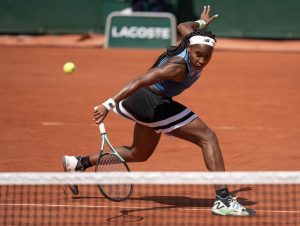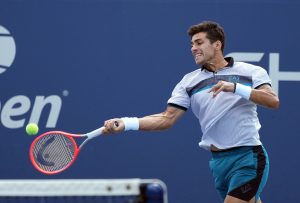Heading into the 2016 Australian Open, Roger Federer had been the only real rival to Novak Djokovic for the past 18 months. During Djokovic’s dominant 2015 season, in which he won three of the four Majors, as well as six Masters 1000 titles and the ATP Finals, the Serb lost just six matches. Federer inflicted three of those defeats. However, all three of Federer’s victories were scored on fast hard courts in Dubai, Cincinnati and Shanghai.
At the Grand Slams, Djokovic proved an insurmountable obstacle. After beating Federer in the 2014 Wimbledon final in an instant classic, Djokovic beat the Swiss again at the All England Club a year later, in more comprehensive fashion than the 7-6 6-7 6-3 6-2 scoreline suggests, and in a closely fought final at the US Open. Those defeats were surely desperately painful for Federer, all the more so because they provided Djokovic with the platform to launch a serious challenge to Federer’s legacy.
Unsurprisingly then, Federer was eager to arrest that slide at Melbourne Park. And he delivered some statement wins en route to the semifinals, hammering Tomas Berdych and David Goffin. Djokovic, meanwhile, had to come through a marathon battle with Gilles Simon in the fourth round, in which the Frenchman slow-balled the world #1 into hitting 100 unforced errors. But Djokovic found a way to win that match, before getting back to his best in a straight-sets win over Kei Nishikori in the last eight.
And as he has shown throughout his career, particularly at the Australian Open, there is no one as good at finding their focus when it matters most as Djokovic. Federer was to discover that in the most painful way possible.
The Match
Djokovic took just 22 minutes to win the first set. He controlled the baseline, keeping pace with Federer in fast-paced rallies and not allowing Federer to rush him. He was both consistent and aggressive, hitting numerous winners at the cost of just two unforced errors. His serve was also effective, with Djokovic’s ability to hit his spots time and again preventing Federer from mounting any real pressure whilst the Serbian was at the line. To make matters worse, Djokovic struck some sublime winners, notably a passing shot winner at 15-15 in the final game of the set.
Things did not improve for Federer in the second set. Despite his efforts to stay aggressive and force Djokovic out of position, he simply wasn’t able to snap Djokovic out of his rhythm. More than once, Federer probed Djokovic’s defences, only for the defending champion to ratchet up the intensity before driving a winner past a helpless Federer. In just 54 minutes, Djokovic had raced to a 6-1 6-2 lead, having hit 17 winners and only 6 unforced errors.
But in the third set, Federer, despite looking every inch a beaten man, dug in. He upped the level of risk in his game, shortening the rallies by going for winners early and rushing the net at every opportunity. That served to disrupt Djokovic’s rhythm just enough for Federer to force his way back into the contest. The Swiss then strung some good points together to break Djokovic’s serve in the sixth game of the set after a titanic struggle, before holding off Djokovic’s attempts to get back into the set.
Heading into the fourth, it appeared that Federer might have the momentum. But a ten minute delay as the roof was closed gave Djokovic the perfect chance to gather his thoughts. And he took full advantage. Federer still had his moments, taking a 0-30 lead in Djokovic’s first service game of the set and hitting an astonishing pass at 3-4 15-30 to win what was unquestionably the best point of the match. But he was not able to take his chances.
Djokovic, in contrast, was ruthless when it mattered most. Indeed, whilst Federer may have won the point of the match in the eighth game of the fourth set, it was also the last point he won in the match. At 30-30, Federer served and volleyed behind his second delivery only for Djokovic’s forehand pass to clip the top of the net and race past Federer’s racquet, leaving the Swiss staring down the barrel. His response was to serve and volley once again behind his second serve, but Djokovic was waiting for him.
The world #1 stepped around his backhand and lashed a forehand return at Federer’s shoelaces. Federer did well to get his racquet on it, but had no chance of getting the ball back in to play. And just like that, Djokovic had struck the decisive blow. Without breaking stride, Djokovic served the match out to love to complete a stunning 6-1 6-2 3-6 6-3 win and claim his place in a sixth Australian Open final.
The aftermath
Despite the nature of his defeat in the last four, the Australian Open arguably proved to be the high point of Federer’s 2016. He played just seven tournaments that season, failing to win a trophy, and was plagued with misfortune throughout. He first injured his knee preparing a bath for his children, before a virus delayed his comeback at the Miami Open. A back injury then kept him out of the French Open, before he fell in five sets to Milos Raonic in the last four at Wimbledon.
Federer called time on his season in the wake of that loss, choosing to spend the next six months recuperating in an attempt to get back to his best. It proved to be an inspired decision. In 2017, Federer enjoyed his best season since 2010, winning two Grand Slams at the Australian Open and Wimbledon. That set him up to reclaim the world #1 ranking in 2018 after successfully defending his Australian Open title.
Djokovic, meanwhile, went on to dominate the first half of the 2016 season. He beat Andy Murray in straight-sets in the Australian Open final, before completing the Sunshine Double in Indian Wells and Miami. On the clay in Europe, he won the Madrid Open before finally completing the career-Grand Slam at Roland Garros, beating Andy Murray in the final again, where he also became the first man since Rod Laver to hold all four Major titles.
Thereafter, however, his form faltered badly. A loss of motivation, coupled with a serious elbow injury that eventually required surgery, saw him fall down the rankings over the next two years, enduring an extended period in the tennis wilderness, with Andy Murray finishing 2016 as the world #1. But just as Federer and Rafael Nadal did, Djokovic showed that class is permanent, as he enjoyed a resurgent 2018, re-establishing himself as a force at the top of the game, eventually returning to the rankings penthouse.
Main photo:
Embed from Getty Images






